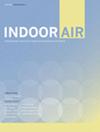盐湖城环境空气环氧乙烷模拟估算的设施堆和逸散排放与基于罐的环境空气测量的比较
IF 4.3
2区 环境科学与生态学
Q1 CONSTRUCTION & BUILDING TECHNOLOGY
引用次数: 0
摘要
环氧乙烷(EtO)是一种在室温下由乙烯催化氧化产生的无色可燃气体。EtO广泛用于医疗消毒设施,用于清洁医疗用品和设备。最近的流行病学研究表明,EtO是一种比以前记录的更强的致癌物,这导致美国环境保护署(EPA)在2016年12月更新了EtO的吸入单位风险估计。这导致在美国包括犹他州在内的几个地区将电子商务组织确定为潜在的健康问题。盐湖谷周围的地理环境形成了一个“碗”,是收集空气污染排放的理想场所。该地区经常经历逆温事件,这抑制了垂直混合,造成空气污染物的积累,导致不健康的污染水平。使用EPA的分散建模软件AERMOD,本研究通过设施堆和逸散排放建模结果估计了EtO浓度。这些值与盐湖谷医疗器械灭菌设施附近采集的环境空气样本的罐基浓度进行了比较。采用不锈钢全空气钝化罐采集24 h环境浓度EtO样品。选择盐湖谷医疗器械消毒设施周围的8个地点和4个背景地点测量环境浓度。考虑到大气对EtO的潜在影响,在2022年冬季(1月至3月)和2022年夏季(7月至9月)对测量数据进行了采样。对模拟的EtO浓度进行了调整,以考虑与冬季或夏季数据相关的背景值。然后,使用Wilcoxon符号排序配对检验对两种方法进行比较。统计分析结果显示,在将基于罐的环境EtO测量值与模型估计值进行比较时,灭菌设施周围的8个样本位置中有6个存在显著差异。在站点1、3和4进行的基于罐的测量在统计上大于模型估计,而站点2、5和7在统计上小于模型估计。夏季的背景值几乎是冬季的2.5倍。结果并没有表明一种方法是否比另一种方法更保守。综上所述,当比较测量和模拟的环境EtO浓度时,最近的5个站点和7个站点存在统计学差异。比较结果并没有明确表明是否可以为未来的人类暴露于癌症风险评估模型推导出校正因子。然而,离灭菌设施越近,总暴露量越大是合理的。本文章由计算机程序翻译,如有差异,请以英文原文为准。
A Comparison of Ambient Air Ethylene Oxide Modeling Estimates from Facility Stack and Fugitive Emissions to Canister-Based Ambient Air Measurements in Salt Lake City
Ethylene oxide (EtO) is a colorless, flammable gas at room temperature produced by the catalytic oxidation of ethylene. EtO is widely used by medical sterilization facilities to clean medical supplies and equipment. Recent epidemiological studies showed that EtO is a more potent carcinogen than previously documented, leading the Environmental Protection Agency (EPA) to update, in December 2016, the inhalation unit risk estimate for EtO. This resulted in the identification of EtO as a potential health concern in several areas across the US, including the state of Utah. The geography surrounding Salt Lake Valley creates a bowl, which is ideal for collecting air pollution emissions. The region often experiences inversion episodes which inhibit vertical mixing and cause an accumulation of air pollutants, leading to unhealthy pollution levels. Using the EPA’s dispersion modeling software, AERMOD, this study estimated EtO concentrations through facility stack and fugitive emissions modeling results. These values were compared with those of canister-based concentrations from ambient air samples taken near a medical device sterilization facility in Salt Lake Valley. Stainless steel whole-air passivated canisters were used to collect 24 h ambient concentration samples of EtO. Eight locations surrounding a Salt Lake Valley medical device sterilization facility and four background sites were chosen to measure the ambient concentrations. Accounting for potential atmospheric impacts on EtO, measurements were sampled in winter 2022 (January–March) and summer 2022 (July–September). The modeled EtO concentrations were adjusted to account for background values associated with the winter or summer data. Then, the two methodologies were compared using a Wilcoxon signed-ranked paired test. The statistical analysis resulted in six of the eight sample locations surrounding the sterilization facility being significantly different when comparing the canister-based measurements of ambient EtO to modeled estimates. Canister-based measurements taken at sites one, three, and four were statistically greater than the modeled estimates, while sites two, five, and seven were statistically less than the modeled estimates. Also, the summer background value calculated was almost 2.5 times greater than the winter one. The results do not suggest whether one method is more or less conservative than the other. In conclusion, the five of the closest sites and site seven were statistically different when comparing measured and modeled ambient concentrations of EtO. The comparison results do not clearly indicate if a correction factor could be derived for future human exposure to cancer risk assessment modeling. However, it is reasonable that the closer to the sterilization facility, the more total EtO exposure will be realized.
求助全文
通过发布文献求助,成功后即可免费获取论文全文。
去求助
来源期刊

Indoor air
环境科学-工程:环境
CiteScore
10.80
自引率
10.30%
发文量
175
审稿时长
3 months
期刊介绍:
The quality of the environment within buildings is a topic of major importance for public health.
Indoor Air provides a location for reporting original research results in the broad area defined by the indoor environment of non-industrial buildings. An international journal with multidisciplinary content, Indoor Air publishes papers reflecting the broad categories of interest in this field: health effects; thermal comfort; monitoring and modelling; source characterization; ventilation and other environmental control techniques.
The research results present the basic information to allow designers, building owners, and operators to provide a healthy and comfortable environment for building occupants, as well as giving medical practitioners information on how to deal with illnesses related to the indoor environment.
 求助内容:
求助内容: 应助结果提醒方式:
应助结果提醒方式:


